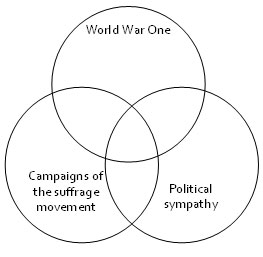Edexcel - AS GCE Unit 2: British History Depth Studies Option C
Edexcel: C2: Britain, c.1860-1930: The Changing Position of Women and the Suffrage Question
Teaching Activities
Teaching Activities
- Reasons for the granting of female suffrage in 1918: Venn Diagram
As a class, produce a list of reasons for the granting of female suffrage in 1918. Students should be given an A3 copy of the following Venn diagram:

Students should then place each factor onto the Venn diagram, showing the ways in which different factors relate to each other.
Hints:
- Less able students could be given a list of reasons for the granting of female suffrage, which they then place on the diagram.
- The most able students could be encouraged to use different colours to emphasise the relative importance of the different factors. For example, factors which are most important could be red, while those which are least important could be blue. Having categorised reasons in order of relative importance, the students should be asked to write a paragraph explaining which factor was most important and why.
- Make your own exam paper
Students should be shown a range of existing exam papers for this option. They should make a list of the key features of the exam papers. For example, they could note that the paper is divided into two sections, with the first section requiring comparison of three sources, and the second section requiring them to test a judgement using two sources and their own knowledge.
Students should then use their own knowledge and a copy of the specification to design their own Part (a) and Part (b) questions.
For the Part (a) question, they should select three sources from their textbook or other relevant books (additionally, they could be encouraged to use online libraries such as Google Books). At least two of these sources should be primary accounts. Having chosen the sources, students should write an appropriate question to accompany them. This question should focus on a comparison of the three sources.
For the Part (b) question, students should select two secondary sources, offering contrasting interpretations of a key event or process studied. Again, having chosen the sources, students should write an appropriate question to accompany them. This question must require them to test an interpretation.
Hints:
- Once the exam papers have been designed, students should swap papers with a partner, and plan their answers to the questions. They should return these to the person who designed the exam paper, who could mark them using the exam board mark scheme.
- Less able students could be given eight or nine sources from which to select their sources for each question.

